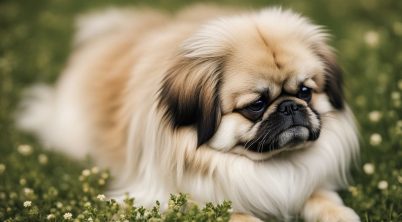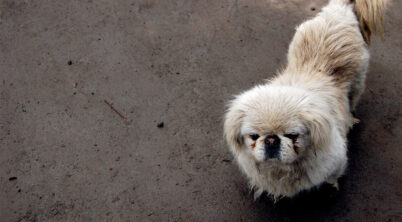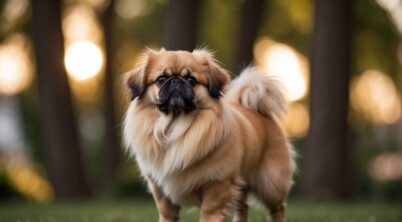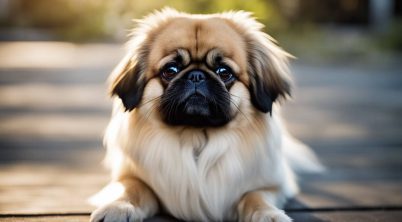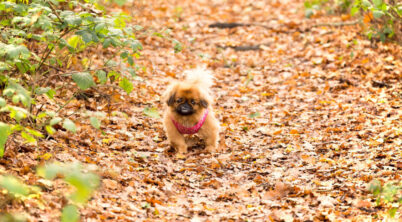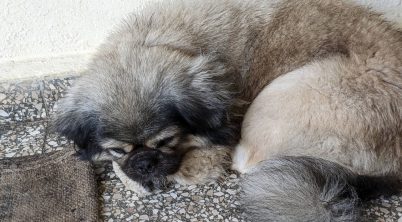Table of Contents
The Imperial Dog with a Rich History
The Pekingese breed has a storied history, closely intertwined with the echelons of Chinese imperial legacy. They were revered within the Chinese Imperial court and were owned exclusively by members of the Chinese imperial family. They were not just pets but symbols of stature and regal elegance, often associated with the lion, an animal symbolic of Buddhist lore and imperial power. The presence of a Pekingese was a sign of sovereignty and wealth for centuries.
One Pekingese in particular, Looty, holds a unique position in the breed’s journey from the East to the Western world. This female Pekingese was acquired under controversial circumstances by Captain John Hart Dunne during the looting of the Old Summer Palace in Beijing in October 1860. This event was a part of the Second Opium War, a period marked by conflict and cultural plunder. Captain Dunne later presented the small dog to Queen Victoria, who named her Looty after the manner in which she was brought to England. This gift may have been the principal entry of the Pekingese dog into Europe, setting off a fascination with the breed among Western dog enthusiasts.
Queen Victoria’s acceptance of Looty into the Royal Collection of Dogs essentially became a catalyst for the breed’s popularity in Britain. Looty lived out her life among the British aristocracy, eventually passing away in 1872 and was buried at Windsor Castle. Her introduction marked the beginning of the Pekingese as a fashionable breed among the British upper classes, a legacy that continues to this day. Though her story begins with an act of war, Looty’s impact on the perception and popularity of the Pekingese dog in the West is undisputed.
Historical Context
The Pekingese breed and their journey to the West is entwined with pivotal events in 19th century China, most notably the looting of the Old Summer Palace during the Second Opium War.
Origins of the Pekingese Breed
The Pekingese dog is an ancient toy breed, deeply embedded in Chinese history and culture. Originating in Beijing, then known as Peking, these small dogs were revered in Imperial China. They were often referred to as “lion dogs” due to their resemblance to Chinese guardian lions. The Pekingese were companions to the Chinese Imperial family and nobility, with their breeding and ownership strictly regulated.
The Second Opium War and Imperial China
The Second Opium War (1856-1860), involving China and the foreign powers of Britain and France, marked a period of intense conflict and eventually led to significant looting and destruction. In 1860, the Old Summer Palace, or Yuanmingyuan, located in Beijing, became a target during the culmination of this conflict. As the British and French soldiers looted Yuanmingyuan, they came across a small dog, later named Looty, among the priceless treasures taken from the once magnificent palace. This looting was symbolic of British Imperialism’s profound impact on China, signaling a broader cultural and geopolitical theft during the Opium Wars. Looty, regarded as the first Pekingese to be brought to England, was presented to Queen Victoria and marked the beginning of the breed’s presence and popularity in Western society.
Looty: From Peking to Windsor
This section explores the remarkable transcontinental journey of the Pekingese dog named Looty, from her discovery in Peking to her life at Windsor Castle, and her relationship with Queen Victoria.
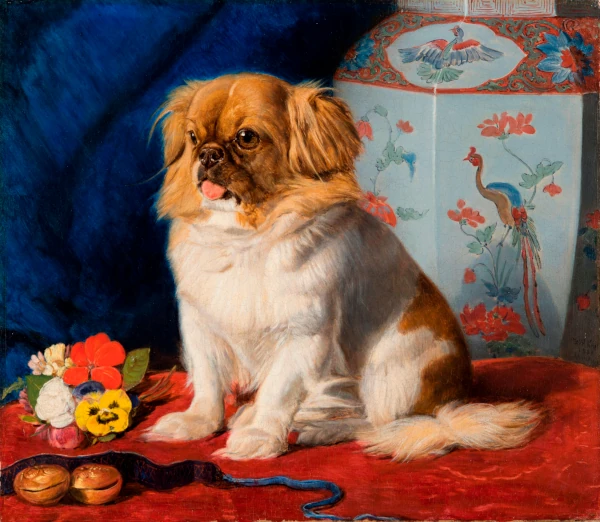
Looty’s Discovery
In 1860, during the looting of the Old Summer Palace in Peking amidst the Second Opium War, Captain John Hart Dunne encountered a small Pekingese dog. The breed, deeply rooted in Chinese imperial legacy, was treasured within the royal sphere. Captain Dunne, intrigued by the dog’s regal bearing amidst the chaos, decided to take her back to England. This dog would later be named Looty, a name reflecting her provenance during the conflict.
Looty’s Journey West
Upon arrival in Britain, Looty’s distinctively luxurious and exotic appeal caught the attention of the royal family. She was presented as a gift to Queen Victoria, thus becoming a part of the Royal Collection of Dogs at Windsor Castle. Here are the key details of Looty’s new life:
- Location of Residence: Windsor Castle
- New Owner: Queen Victoria
- Significance: Looty’s arrival marked the introduction of the Pekingese breed to Western high society, sparking a trend for Oriental luxury within the British aristocracy.
Queen Victoria, renowned for her love of animals, took an immediate fondness to Looty. The Pekingese dog served as a living representation of the richness of Eastern culture within the Royal Court and symbolized the expanding global influences of the British Empire. Looty lived out her days surrounded by opulence in Windsor until her death in 1872, after which she was given a final resting place on the castle grounds.
The Pekingese Dog
The Pekingese is a dog breed steeped in rich history and oriental heritage, known for its distinctive physical attributes and spirited temperament reflective of the cultural significance it held in Asia.
Physical Characteristics
Pekingese dogs are recognized by their compact, stocky frames, a defining feature of this toy breed. They typically weigh between 7 to 14 pounds and have a lion-like mane that puffs out around their head, framing their flat, expressive faces. Their double coat can come in various colors and requires regular grooming. Characteristics include:
- Body: Short, well-built with a noticeable pear shape.
- Head: Large in comparison to the body, with a short, wide muzzle.
- Eyes: Dark, round, and set wide apart, giving a distinctive, intelligent expression.
- Nose: Black, with wide nostrils; set between the eyes.
- Ears: Heart-shaped, set against the head, and often covered with long feathering.
- Tail: High-set, carried well arched over the back with abundant feathering.
Temperament and Care
Pekingese dogs are known for their loyalty and courageous spirit. While they often display an affectionate nature towards their owners, they can be wary of strangers and may exhibit imperial tendencies, a nod to their roots in Chinese nobility. The breed possesses an inherent dignity and self-importance, often described as having cat-like, or oriental habits. Adjusting to various cultures, they can be quite adaptable but do not tolerate rough handling well, making them better suited for homes without very young children.
Their care involves regular:
- Grooming: Daily brushing is crucial to prevent matting, and professional grooming every few months can keep the coat in good condition.
- Exercise: Though small, they benefit from daily walks and playtime to maintain a healthy weight and stimulate their mind.
- Health checks: Breeding practices have made certain lines prone to specific health issues, such as respiratory and eye problems, making regular veterinary check-ups important.
Engaging patiently in the breeding and training of Pekingese dogs can be a rewarding experience, highlighting one’s respect for the breed’s venerable ancestry and complex character.
Cultural Significance
The Pekingese breed, exemplified by Looty, holds complex layers of cultural significance, from its symbolism in its native China to its impact upon arrival in the Western world.
Symbolism and Imperial Favor
The Pekingese breed has long been associated with the Chinese Imperial Family, symbolizing both regal elegance and spiritual reverence. The breed was believed to be semi-divine and closely linked with Buddhist ideology, where they were considered akin to lions, which feature heavily in Buddhist mythology. The dogs were exclusively owned by members of the imperial court—embodying a physical manifestation of luxury and isolation from common society. The possession and gifting of such dogs were indicative of high status and imperial favor.
Influence on Western Perception of the East
Looty’s arrival in England and subsequent presentation to Queen Victoria significantly shaped the British middle class‘ perception of Eastern cultures, fostering a fascination with what they considered exotic oriental habits. The Pekingese came to represent a living souvenir of the East, eliciting both admiration and critique within a society captivated by foreign novelties. This fascination led to a luxury craze among the British middle class as owning something from a culture perceived as mysterious and opulent became highly desirable. Yet, the manner of Looty’s acquisition highlighted imperialistic undertones, serving as a reminder of the darker aspects of British imperialism’s impact on other cultures.
Queen Victoria’s Royal Pets
Queen Victoria’s affinity for her pets, particularly the famous Pekingese Looty, was well documented and had a significant impact on canine fashion and the prevalence of dogs as companion animals in Victorian society.
The Royal Menagerie
Queen Victoria had an extensive collection of pets, with dogs being among her favorites. The Royal Collection of Dogs was an assemblage of various breeds that resided at Buckingham Palace and Windsor Castle. Their care was of paramount importance and a reflection of the Queen’s compassion for animals. A notable addition to this collection was Looty, a Pekingese dog who became an emblem of royal affection.
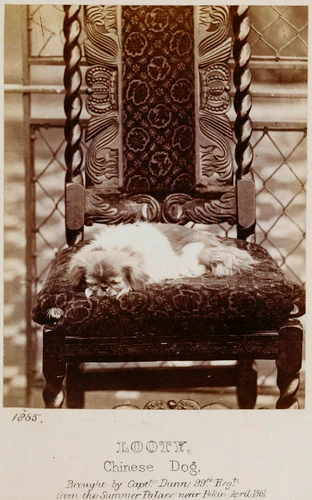
History plays a pivotal role in the tale of Looty. The dog was acquired during the looting of the Old Summer Palace near Beijing in 1860 by Captain John Hart Dunne. Presented to Queen Victoria, Looty joined the esteemed Royal Collection, becoming a living symbol of the era’s complex international relations.
Public Fascination with the Royal Dogs
The public’s fascination with Queen Victoria’s dogs was considerable, and her pets often set trends among the British aristocracy. Looty was particularly influential, initiating a fashion for Pekingese dogs in Victorian Britain. This trend was further exemplified when the Duchess of Richmond was gifted with two of Looty’s offspring.
In the inventory of Queen Victoria’s pets, one might even find mention of Silver Bells, a favorite of the Queen’s collies. The Royal dogs, having been regularly depicted in portraits and photographs, turned into celebrities of their time, with the public avidly following news about their comings and goings and their participation in royal affairs.
Artistic Representations
In the realm of art, Looty, the Pekingese, has been immortalized through specific works that capture her historical and cultural significance.
Portrait of Looty
Friedrich Wilhelm Keyl, a German artist, is notably credited with painting Looty’s portrait in 1861. This painting was created after Looty was brought from China to England. The visual representation by Keyl showcases Looty in an obedient sit, highlighting her distinctive white and nut-brown fur. Notably, this portrait does not only depict the dog but also includes a Japanese Vase, suggesting a connection to Eastern extravagance and craftsmanship.
- Artist: F.W. Keyl
- Year: 1861
- Elements in the portrayal:
- Looty: depicted in a seated position
- Background: includes a Japanese Vase
Depictions in British Art
Looty’s image transcended the singular portrayal by Keyl, fostering further representations within British art. Following her introduction to Queen Victoria by Captain John Hart Dunne, and her integration into the Royal Collection of Dogs, Looty became a canine muse of sorts. While formal records of each depiction are limited, replicas and inspired works may have circulated, noting her as a subject symbolizing both the spoils of war and a nascent curiosity in Eastern cultures.
The legacy of Looty’s imagery is also partly documented in photography. William Bambridge, who served as the Queen’s photographer, likely captured Looty’s likeness in this medium, although specific photographs by Bambridge featuring Looty have not been confirmed in public records.
- Known depictions:
- Potential replicas
- Photographs (unconfirmed)
- Associated names:
- William Bambridge: Queen’s photographer
- Royal Academy: Potential venue for exhibition of artworks featuring Looty
Legacy and Breeding
The breeding and legacy of Pekingese dogs like Looty played a pivotal role in shaping the dog’s historical and cultural significance, particularly in Great Britain, and influenced the wider purebred breeding practices across the globe.
Development of the Pekingese in England
After Looty’s arrival in England, the Pekingese became a symbol of status and luxury. Early British breeding programs focused on preserving the distinct characteristics of these imperial dogs. The Kennel Club, established in Great Britain, offered a platform to standardize purebred dog breeds, including the Pekingese. These breeding efforts maintained the breed’s unique features, such as their flat face, lion-like mane, and rolling gait, which were highly valued among British aristocrats.
Global Popularity and Modern Breeding Practices
The lineage of dogs like Looty significantly contributed to the Pekingese’s global popularity. From the intricate breeding process begun in England, Pekingese dogs spread worldwide, influencing the development of other breeds such as the Shih Tzu and Lhasa Apso. Similar breeds, like the Tibetan Mastiff and Pugs, also saw a surge in breeding activities. Modern breeding practices emphasize genetic diversity and health, as demonstrated by the contrast to the selective and distinctive breeding of breeds like the Doberman Pinscher and Teddy Roosevelt Terrier. Today, responsible breeders and organizations continue to uphold standards that prioritize the health and welfare of purebred dogs like the Pekingese, going beyond just physical characteristics to ensure the longevity and well-being of the breed.
Conservation and Reflection
The discussion of Looty the Pekingese involves confronting the complex history of cultural artifacts and the legacies of colonialism. It is a reflection on the encounter of Western powers with the wealth and heritage of the Qing dynasty’s China.
Stolen Artifacts and Historical Trauma
Yuanmingyuan, commonly known in English as the Old Summer Palace, was the cultural and architectural pinnacle of the Qing dynasty. In October 1860, Anglo-French invaders looted Yuanmingyuan, which led to the widespread loss of invaluable historical treasures. This looting resulted in deep trauma within China, as thousands of artifacts were torn from their context. Historians note that tangible heritage such as art, including pets like Looty, symbolized the broader cultural violence endured.
The event was marked not only by looting but by significant destruction and death. The subsequent shock to the Chinese populace was profound, with reports of individuals, including royals, choosing suicide in the face of such overwhelming loss.
Perspectives on Looty and the Summer Palace
Looty’s story is emblematic of the contentious history of stolen objects. As a living being taken during the sacking of the Summer Palace, she serves as a unique point of intersection between living property and cultural artifact. Her life in Queen Victoria’s court draws a sharp contrast to her origin amidst war and trauma.
Today, many consider the circumstances under which Looty became part of the Royal Collection to be representative of a broader pattern of historical injustices, raising questions about conservation and ownership of cultural heritage. Looty’s tale offers a platform for dialogue on these sensitive topics, inviting diverse perspectives to reconcile with the past.

